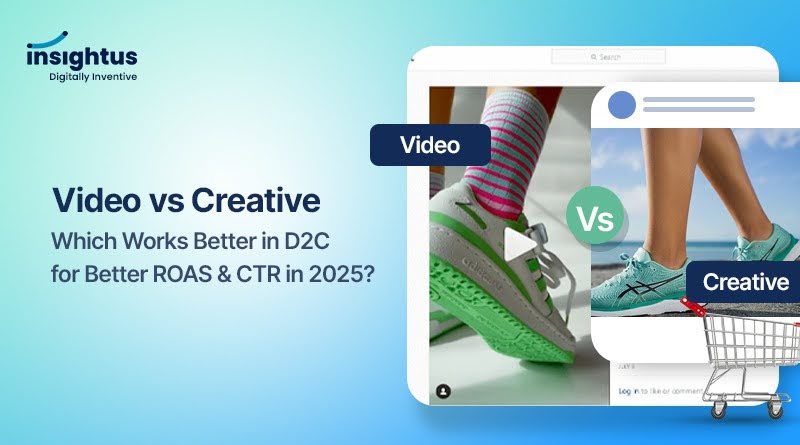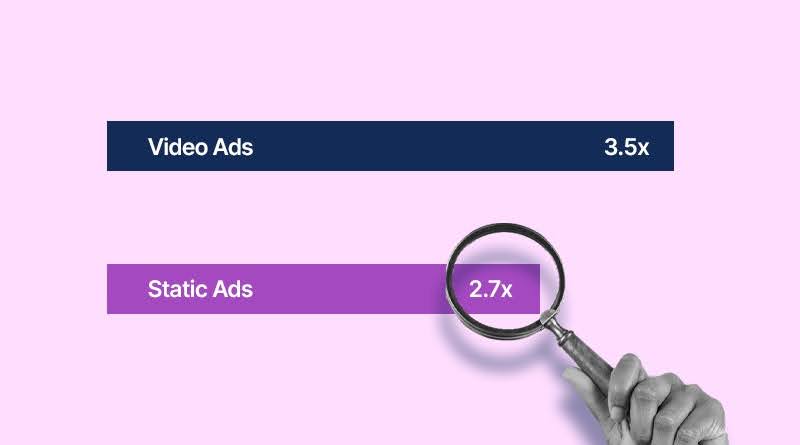With digital advertising evolving rapidly, Direct-to-Consumer (D2C) brands are constantly optimizing their ad strategies to maximize Return on Ad Spend (ROAS) and Click-Through Rate (CTR). In 2025, the battle between video ads and static creative ads continues, but which one truly delivers better results?

Video vs Creative: A Deep Dive
Video Ads
Video ads are dynamic, engaging, and allow brands to tell a compelling story visually. Platforms like Instagram Reels, YouTube Shorts, and TikTok have significantly increased video consumption, making video ads a powerful tool for D2C brands. Additionally, AI-driven video creation tools have made video production more accessible, allowing even small brands to produce high-quality content.
- Higher Engagement: Users spend 88% more time on websites with video content. Research shows that videos with an emotional hook result in 1.5x higher retention.
- Better Conversion: Video ads can increase purchase intent by 97% compared to static ads, as they effectively showcase product benefits.
- Growing Popularity: Video accounts for 82% of all internet traffic in 2025, with vertical videos seeing a 65% higher engagement rate than traditional formats.
- AI-Powered Personalization: AI-driven tools now allow brands to create personalized video ads at scale, boosting CTR by 45% compared to non-personalized content.
- Shoppable Videos: Interactive videos with embedded shopping links have driven a 25% increase in direct sales for D2C brands.

Static Creative Ads
Static creative ads (images, carousels, and infographics) remain a staple in digital marketing due to their simplicity and quick consumption. While they may lack motion, they are often more effective for direct conversion strategies and performance marketing.
- Faster Load Times: Unlike video, images load instantly and don’t require buffering, making them ideal for mobile users with limited connectivity.
- Lower Production Cost: Creating high-quality static creatives is cheaper than producing professional videos, making them a cost-effective solution for startups.
- Effective for Retargeting: Many brands use static ads for retargeting abandoned carts or promoting limited-time offers, as they require minimal cognitive load from users.
- Predictable Performance: Unlike videos, which rely on engagement and watch time, static ads deliver consistent CPC (Cost per Click) metrics, allowing for stable ROI calculations.
Data-Driven Insights: ROAS & CTR Comparison
To determine which format works best, let’s look at some real-world data from D2C brands across various industries.
| Ad Type | Average ROAS (2025) | Average CTR (2025) | Engagement Rate |
| Video Ads | 3.5x | 1.8% | 7.2% |
| Static Ads | 2.7x | 1.2% | 4.5% |
Key Takeaways:
- Video ads generate 30% higher ROAS than static ads, particularly in lifestyle, beauty, and fitness industries.
- Video ads achieve 50% higher CTR than static creatives, making them more effective for awareness campaigns.
- Brands investing in high-quality video ads see a 20% increase in engagement, leading to better customer retention.
- Mobile-first strategies leveraging vertical videos outperform traditional static formats on Instagram and TikTok.

Real Examples of D2C Brands Winning with Video & Static Ads
1. Brand A (Beauty & Skincare) – Video Success Story
A premium skincare brand used Instagram Reels & TikTok video ads to showcase how their product works in real time. They saw:
- 4.2x ROAS, compared to 2.5x from static ads.
- A 60% increase in conversions due to interactive video content.
- Higher engagement, with users commenting, sharing, and saving videos for later.
- User-Generated Content (UGC) Strategy: Partnering with influencers and micro-creators led to an additional 18% lift in organic reach.
2. Brand B (Fashion) – Static Ads for Retargeting
An online fashion retailer leveraged static creatives for retargeting abandoned carts and promoting time-sensitive discounts. The result:
- 3.1x ROAS, better than their video retargeting campaign.
- Quick conversions, as users already had intent to buy.
- Lower CPA (Cost per Acquisition) by 12%, as static ads were cost-effective for remarketing purposes.
Which One Should You Use? Expert Recommendations
The answer isn’t one-size-fits-all. Here’s a breakdown based on different campaign goals:
| Campaign Goal | Recommended Ad Type |
| Brand Awareness | Video Ads (Short-Form, Interactive) |
| Engagement & Social Shares | Video Ads (UGC, Storytelling) |
| Retargeting & Conversions | Static Creatives (Carousels, Infographics) |
| Product Demonstration | Video Ads (Explainers, How-To) |
| Time-Sensitive Offers | Static Ads (Flash Sales, Discounts) |
- Use video ads for awareness, engagement, and storytelling, particularly on social media platforms.
- Use static creatives for retargeting, quick promotions, and performance-driven campaigns.
- Hybrid Approach: Brands combining both formats see 35% better ad performance than using just one.

Conclusion: The Future is Video-First, But Static Still Works
In 2025, video ads are the undisputed winner in D2C advertising for higher ROAS & CTR. However, static ads still play a critical role, especially for retargeting and direct-response campaigns.
Final Expert Tip:
- Leverage AI-driven video creation for cost-effective, personalized content.
- Test interactive and shoppable video formats to enhance engagement.
- A/B test both formats, track key metrics, and let data drive your strategy to maximize ROAS & CTR

